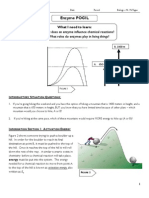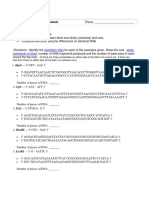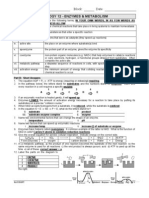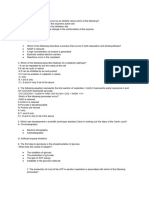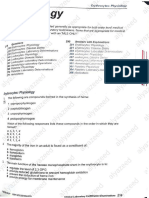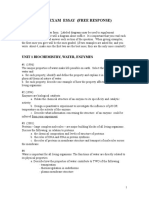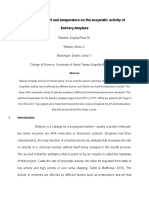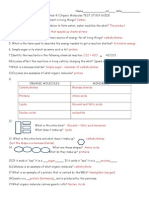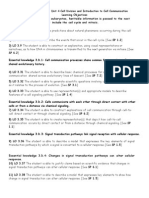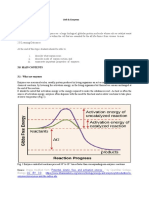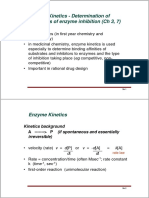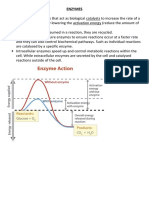Enzymereview 2008 Key
Enzymereview 2008 Key
Uploaded by
api-237676607Copyright:
Available Formats
Enzymereview 2008 Key
Enzymereview 2008 Key
Uploaded by
api-237676607Original Title
Copyright
Available Formats
Share this document
Did you find this document useful?
Is this content inappropriate?
Copyright:
Available Formats
Enzymereview 2008 Key
Enzymereview 2008 Key
Uploaded by
api-237676607Copyright:
Available Formats
Period
---
Date _ _ _ _ _ _ _ _ __
Regents Biology
ENZYME REVIEW
1. An enzyme and four different molecules are shown in the diagram below.
Enzyme
Molecules:
(>
( 0 )
(C)
(B)
(A)
The enzyme would most likely affect reactions involving
(1) molecule A, only
@n0lecule C, only
(3) molecules 8 and 0
(4) molecules A and C
2. Base your answers to questions 2 through 4 on the diagram below that represents a human
enzyme and four types of molecules present in a solution in a flask.
Molecules
Enzyme
o
B
Which molecule would most likely react with the enzyme?
3. Explain your answer to question 2. What principle about how enzymes work does the question
illustrate?
t fin
tf.., eeli sik k.rl
0+ ur~5
!h,i k
1 of 4
kkr
on5
II.. 5pto'hc/1y
Name __________________________
Regents Biology
4. Match the enzymes with their substrates and functions.
~ A. amylase
1. synthesizes DNA
~ B. protease
2. digests sugar in beer (maltose)
~ C.lactase
3. digests starch (amylose)
---L D. DNA polymerase
4. synthesizes ATP
~ E.maltase
5. digests milk sugar (lactose)
~ F. ATP synthase
6. digests proteins
5. Base your answers to the following questions on the graph below and on your knowledge of
biology.
Pepsin
Trypsin
(dlg~st~
(digests
protein in
stomach}
o 1
profeln In
IntesHne)
3 4
5 6
8 9 10 11 12 13 14
pH
3____________________________________
6. What is the optimal pH for pepsin? ___
7. Is this pH acid or basic? _-.......:;.A....L..:
6f
:::..:rA
.!......-___________________________________
8. In what organ of the digestive system does pepsin work? __...:::...,:
,S -h
'----=-::...=::....
M.-. (.. l-'---__________
.,
9. What is the optimal pH for ~? --I..L..Lff c ....l._
<L _ _ _ _ _ _ _ _ _ _ _ _ _ _ __
10. In what organ of the digestive system does trypsin work?
---==-~
5,-----,--1/~/..;~. . <. .'--.s:
k _'h_=
. . o. . ;~_____
11. Is this pH acid or basic? ____.=.
6 ...,:-=-Ct s....:.i_,________________________________
12. Neither enzyme works at a pHs of __~~)r_'_--O I L -/'--i
L--------------
2 of 4
Name
Regents Biology
-------------------------
13. An incomplete graph is shown below. What two internal body conditions could appropriately
be used to replace letter Z on the axis?
Effect of Z on Enzyme Activity
14. What kind of organic molecule is an enzyme?
15. List 2 internal environmental factors that affect how well enzymes function.
16. What happens to water when you heat it to 100C?
~ Bv,)r
17. What happens to proteins dissolved in that water when you heat it to 100C?
18. What specific change happens to an enzyme that stops it from working when you heat it?
C/tMg<
I;'
5&..,e
of t;.c.liv~ s ik
19. Explain why changing the shape of an enzyme could affect the ability of the enzyme to
function.
S bs~h
V1
c-, '/
ItJ:& lA.~hv~
3 of 4
Sik
Name _________________________
Regents Biology
20 . Draw a generalized graph of the action of an enzyme from the human body as the
temperature changes from OC to 100C. Mark the temperature of optimal enzyme activity.
t-k of
Ellb,/lU.
I
I
"../
/
V
~4/11 J kc.h~J ~f'rt
/
i) - /ot> . c.
\,
1\
\\
1\
\
~
21 . What most likely happens to the rate of reaction of a human enzyme when the temperature
is increased gradually from 10C to 30C. Explain your answer.
71- I~ CA'~t,u M()/e CA.J~ s ~Ov~ ;;sb
J. oil(;/,
~r~
tJ/k.
22. What most likely happens to the rate of reaction of a human enzyme when the temperature
is increased gradually from 40C to 90C. Explain your answer.
Lf
,J.e C-C'Cw
r ,
M6t lM ft. s 1'1<.."
<
s.
lsI AI..;t... U/ 7p'-'
3?PI"
23. What is the optimal temperature for the functionality of a human enzyme? __---'-_L_ ______
4 of 4
You might also like
- Enzyme POGILDocument6 pagesEnzyme POGILnewhaventeacherNo ratings yet
- STPM Chemistry Term 1 Topic 6A Chemical EquilibriumDocument23 pagesSTPM Chemistry Term 1 Topic 6A Chemical EquilibriumChris Lau100% (7)
- O Level Biology Practice Questions And Answers EnzymesFrom EverandO Level Biology Practice Questions And Answers EnzymesRating: 5 out of 5 stars5/5 (1)
- BIOCHEM LAB - Enzymatic Activity of Salivary AmylaseDocument6 pagesBIOCHEM LAB - Enzymatic Activity of Salivary AmylaseIsmael Cortez100% (2)
- Schaum's Easy Outline of Organic Chemistry, Second EditionFrom EverandSchaum's Easy Outline of Organic Chemistry, Second EditionRating: 3.5 out of 5 stars3.5/5 (2)
- Microsoft Word - Restriction Enzymes WorksheetDocument2 pagesMicrosoft Word - Restriction Enzymes WorksheetHaru0% (1)
- Enzyme Review Packet AnswersDocument4 pagesEnzyme Review Packet AnswersJohn gamingNo ratings yet
- 12 - Enzyme Station ActivityDocument16 pages12 - Enzyme Station ActivityanneNo ratings yet
- Worksheet - Enzymes - ReviewDocument3 pagesWorksheet - Enzymes - Reviewapi-270403367100% (1)
- EOC BookletDocument33 pagesEOC BookletHalden LinNo ratings yet
- Enzymes Activity 1 Israhia Joy Copioco Bsmt2bDocument4 pagesEnzymes Activity 1 Israhia Joy Copioco Bsmt2bmythilyn bihagNo ratings yet
- Confidential: ATP SynthetaseDocument5 pagesConfidential: ATP Synthetaseazszah100% (1)
- Unit Test 2 - EnzymeDocument7 pagesUnit Test 2 - EnzymeAyu SriningsihNo ratings yet
- Unlock SGCh06Document6 pagesUnlock SGCh06SilaxNo ratings yet
- 8IC - Bio - Enzymes - WS 1Document5 pages8IC - Bio - Enzymes - WS 1Sujan PNo ratings yet
- Nutrition 314 - Energy Metabolism and Metabolic Integration: Exam 3Document8 pagesNutrition 314 - Energy Metabolism and Metabolic Integration: Exam 3Dancebp4No ratings yet
- First Term STPM BIology Trial (2015-2Document11 pagesFirst Term STPM BIology Trial (2015-2Then Moli50% (2)
- General BIology 1 Q2 M5 SCDocument10 pagesGeneral BIology 1 Q2 M5 SCAldrin James DafunNo ratings yet
- Enzyme LabDocument5 pagesEnzyme LabJane ChongNo ratings yet
- Gaurav Kumar Hemnani - UNIT TEST "Enzyme - Human Excretory System"Document6 pagesGaurav Kumar Hemnani - UNIT TEST "Enzyme - Human Excretory System"Slavic GauravNo ratings yet
- Biology S6Document10 pagesBiology S6AKAYEZU Body santiveNo ratings yet
- Enzyme Worksheet KEY 14kwf3eDocument3 pagesEnzyme Worksheet KEY 14kwf3eBHJJNo ratings yet
- Energy Photosynthesis Respiration TestDocument30 pagesEnergy Photosynthesis Respiration Testapi-237801056No ratings yet
- Form 4 - ch5 - Quiz - 2223 - AnsDocument6 pagesForm 4 - ch5 - Quiz - 2223 - AnsydislikeNo ratings yet
- BBO 2012 Round 2Document24 pagesBBO 2012 Round 2medja2233No ratings yet
- 2021 Level L Biology Periodic 2-Revision Sheets T1 Wk10Document34 pages2021 Level L Biology Periodic 2-Revision Sheets T1 Wk10-Bleh- WalkerNo ratings yet
- Set 2Document7 pagesSet 2JAINo ratings yet
- Overseas Enzyme WorksheetDocument3 pagesOverseas Enzyme Worksheetlinjiale0% (1)
- How An Enzyme's Name Is DeterminedDocument4 pagesHow An Enzyme's Name Is DeterminedCrestore Lex Tapia CapiñaNo ratings yet
- BIO121 - Experiment 4Document7 pagesBIO121 - Experiment 4Tan Ri ShenNo ratings yet
- 2 5336931872452644678Document15 pages2 5336931872452644678UDIT MANCHANDANo ratings yet
- BIO 361 Exam 1 (Fall 2015) With AnswersDocument11 pagesBIO 361 Exam 1 (Fall 2015) With AnswersRuchi Patel100% (1)
- QB Class X , BIologyDocument13 pagesQB Class X , BIologygogamergo80No ratings yet
- (Tr. Thae) Chemistry ExamDocument15 pages(Tr. Thae) Chemistry ExamClaudia WinNo ratings yet
- GenBio1 Week 5 Q2Document27 pagesGenBio1 Week 5 Q2Reygie Ann SuenoNo ratings yet
- POGIL HON Enzyme POGIL Revised F15 KEYDocument6 pagesPOGIL HON Enzyme POGIL Revised F15 KEYstupidNo ratings yet
- Homeostasis Unit Practice QuestionsDocument7 pagesHomeostasis Unit Practice QuestionsAnonymous YwCm6vkNo ratings yet
- Notes For Biology PDFDocument12 pagesNotes For Biology PDFphapalla101No ratings yet
- Untitled document-4Document6 pagesUntitled document-4anarora720sNo ratings yet
- 13 - Enzyme Station Activity Answer Packet 2Document4 pages13 - Enzyme Station Activity Answer Packet 2stevenkreimierNo ratings yet
- ENzymes mcq 15Document6 pagesENzymes mcq 15debjani.bhattacharyaNo ratings yet
- The Metabolism of O - (4 - B R O M O - 2, 5 - Dichlorophenyl) O-Methyl Phenylphosphonothioate (Leptophos) in White Mice and On Cotton PlantsDocument15 pagesThe Metabolism of O - (4 - B R O M O - 2, 5 - Dichlorophenyl) O-Methyl Phenylphosphonothioate (Leptophos) in White Mice and On Cotton PlantsSh1vaNo ratings yet
- Solutions For Biochemistry Unit Exam: H-C-C-H H H H HDocument7 pagesSolutions For Biochemistry Unit Exam: H-C-C-H H H H HTim SilvaNo ratings yet
- Lecture Questions CZB190Document18 pagesLecture Questions CZB190micro0908No ratings yet
- Boc HemaDocument72 pagesBoc HemaFenyl Isis GuigayomaNo ratings yet
- Animal Systems - CardiovascularDocument78 pagesAnimal Systems - CardiovascularMinecraft 1No ratings yet
- Catalase Lab 2014 Key 23Document6 pagesCatalase Lab 2014 Key 23kyungsoo studiesNo ratings yet
- Tutorial 8 - Enzymes and MetabolismDocument13 pagesTutorial 8 - Enzymes and MetabolismSivabalan Sanmugum100% (2)
- 3 Fill in The BlanksDocument22 pages3 Fill in The Blanksapi-342775465No ratings yet
- Ap Biology Exam Essay (Free Response) Questions: Unit 1 Biochemistry, Water, EnzymesDocument37 pagesAp Biology Exam Essay (Free Response) Questions: Unit 1 Biochemistry, Water, EnzymesBeatrice MallariNo ratings yet
- Enzyme KineticsDocument8 pagesEnzyme KineticsKaren Ivy Bacsain100% (1)
- Lab 8Document4 pagesLab 8hamdahNo ratings yet
- Lab 6 - Enzymes FA24Document8 pagesLab 6 - Enzymes FA24bomberboi256No ratings yet
- STAT212 Exam2 2010springDocument3 pagesSTAT212 Exam2 2010springexamkillerNo ratings yet
- The Effects of PH and Temperature On The Enzymatic Activity of Salivary AmylaseDocument9 pagesThe Effects of PH and Temperature On The Enzymatic Activity of Salivary AmylaseMoira Mochie C. BasilioNo ratings yet
- 4 t2.5 Comp EnzymesDocument4 pages4 t2.5 Comp EnzymessushantNo ratings yet
- Circus WorksheetsDocument16 pagesCircus Worksheetsapi-309893409No ratings yet
- All chapter download Biology 10th Edition Solomon Solutions ManualDocument39 pagesAll chapter download Biology 10th Edition Solomon Solutions Manualgasantseraph100% (4)
- The Total Synthesis of Natural ProductsFrom EverandThe Total Synthesis of Natural ProductsJohn ApSimonNo ratings yet
- Practice Makes Perfect in Chemistry: Organic ChemistryFrom EverandPractice Makes Perfect in Chemistry: Organic ChemistryRating: 3 out of 5 stars3/5 (1)
- Quantitative Biological and Clinical Mass Spectrometry: An IntroductionFrom EverandQuantitative Biological and Clinical Mass Spectrometry: An IntroductionNo ratings yet
- Organism Scrapbook 2015Document7 pagesOrganism Scrapbook 2015api-237676607No ratings yet
- O M Study Guide AnswerkeyDocument2 pagesO M Study Guide Answerkeyapi-237676607No ratings yet
- March 2015Document2 pagesMarch 2015api-237676607No ratings yet
- CH 15inheritanceDocument24 pagesCH 15inheritanceapi-237676607No ratings yet
- CH 13meiosis9eDocument34 pagesCH 13meiosis9eapi-237676607No ratings yet
- 11 14 Genetics Test Answer Key Study Guide 2Document1 page11 14 Genetics Test Answer Key Study Guide 2api-237676607No ratings yet
- Studyguide AnswerkeyDocument23 pagesStudyguide Answerkeyapi-237676607No ratings yet
- Unit 4 Cell Division and Cell Communication UnitDocument6 pagesUnit 4 Cell Division and Cell Communication Unitapi-237676607No ratings yet
- Conservators Center Field TripDocument1 pageConservators Center Field Tripapi-237676607No ratings yet
- April 2014 BiologycalendarDocument1 pageApril 2014 Biologycalendarapi-237676607No ratings yet
- Augsept 2014 CalendarbiocullerDocument1 pageAugsept 2014 Calendarbiocullerapi-237676607No ratings yet
- Enzymes: Kamisha L. Johnson-DavisDocument29 pagesEnzymes: Kamisha L. Johnson-DavisWho KnowsNo ratings yet
- Lesson Plan March 29, 2019 Biochemistry Chapter 5 Topic: Enzymes Pp. 43-47Document3 pagesLesson Plan March 29, 2019 Biochemistry Chapter 5 Topic: Enzymes Pp. 43-47enilegnavemartinezNo ratings yet
- Factors Affecting Enzymes ActivityDocument11 pagesFactors Affecting Enzymes ActivityZubair AslamNo ratings yet
- Biological Oxidation: Dr. Hariharan. V Assistant Professor Karpagam Faculty of Medical Sciences CoimbatoreDocument6 pagesBiological Oxidation: Dr. Hariharan. V Assistant Professor Karpagam Faculty of Medical Sciences CoimbatoreGorav SharmaNo ratings yet
- Unit 6: Enzymes: Image Modified From " ," by Openstax College, BiologyDocument4 pagesUnit 6: Enzymes: Image Modified From " ," by Openstax College, BiologyAbraham BanjoNo ratings yet
- Properties of Enzyme Inhibition (CH 3, 7)Document18 pagesProperties of Enzyme Inhibition (CH 3, 7)afaf100% (1)
- Slide Biop Enz KinDocument19 pagesSlide Biop Enz KinFahmi Ramadhan PutraNo ratings yet
- Chapter 2Document2 pagesChapter 2api-304486052No ratings yet
- EnzymesDocument8 pagesEnzymessrinivasanNo ratings yet
- Biochemistry Notes: Unit-5Th EnzymeDocument25 pagesBiochemistry Notes: Unit-5Th EnzymeKartik Rajpoot100% (1)
- CH 3Document19 pagesCH 3Abhishek GiriNo ratings yet
- Lecture - Enzyme SpecificityDocument4 pagesLecture - Enzyme SpecificityshahzebNo ratings yet
- EnzymeDocument80 pagesEnzymeGosa MohammedNo ratings yet
- Boce2626 2017 Test 3 MemoDocument7 pagesBoce2626 2017 Test 3 MemoPaleisah MoagiNo ratings yet
- EnzymeDocument31 pagesEnzymemiriam harriottNo ratings yet
- SM ch3 Bio Shuler 3Document19 pagesSM ch3 Bio Shuler 3Oluwaseun OyekolaNo ratings yet
- Lock and Key Model vs. Induced Fit ModelDocument5 pagesLock and Key Model vs. Induced Fit ModelKrizzia Anne ShengNo ratings yet
- Chapter - 3 ShortDocument4 pagesChapter - 3 ShortNadeem ArainNo ratings yet
- Nife Hydrogenase: Chem 211 ReportDocument24 pagesNife Hydrogenase: Chem 211 ReportRiannNo ratings yet
- QuizDocument14 pagesQuizmnouma1612No ratings yet
- EnzymeDocument39 pagesEnzymeBhaski MadhappanNo ratings yet
- Toothpickase LabDocument2 pagesToothpickase Labjoannekimm150% (1)
- Enzyme and Enzyme Kinetics - 202204261936Document9 pagesEnzyme and Enzyme Kinetics - 202204261936Ej AgsaldaNo ratings yet
- EnzymesDocument6 pagesEnzymesSarah Farhah2000100% (1)
- Biochemistry 9th Edition Campbell Test BankDocument30 pagesBiochemistry 9th Edition Campbell Test Bankspawnerminutiaxae7n100% (36)
- ENZYMESDocument18 pagesENZYMESJennifer DesRochersNo ratings yet
- Enzyme Kinetic ReportDocument7 pagesEnzyme Kinetic ReportHalil Onur AltayNo ratings yet
- Cctarget Multical-Row 1903601 CiblescalibrantDocument6 pagesCctarget Multical-Row 1903601 CiblescalibrantFirman AkoengNo ratings yet
- Enzyme Graph AnswersDocument2 pagesEnzyme Graph AnswersAINo ratings yet
